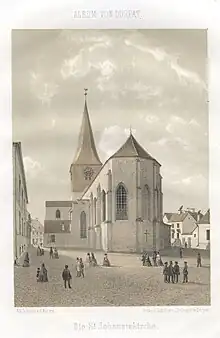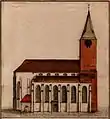| St John's Church, Tartu | |
|---|---|
| Parish Church of Saint John the Baptist, Tartu | |
Estonian: Tartu Jaani kirik | |
 | |
| 58°22′57.72″N 26°43′12.72″E / 58.3827000°N 26.7202000°E | |
| Location | Tartu |
| Address | Jaani 5 |
| Country | |
| Language(s) | Estonian |
| Denomination | Lutheran |
| Previous denomination | Catholic |
| Website | jaanikirik |
| History | |
| Status | Active |
| Founded | 12th century |
| Dedication | John the Baptist |
| Architecture | |
| Functional status | Parish church |
| Heritage designation | Kultuurimälestis (no. 6916) |
| Designated | 16 September 1997 |
| Architectural type | Basilica |
| Style | Gothic |
| Years built | 14th century |
| Groundbreaking | 12th century |
| Specifications | |
| Number of towers | 1 |
| Tower height | 63 metres (206 ft 8 in) |
| Materials | Brick Terracotta (façade) |
| Bells | 3 |
| Administration | |
| Diocese | Southern Region |
| Deanery | Tartu |
| Parish | St John's in Tartu |
| Clergy | |
| Bishop(s) | Joel Luhamets |
| Rector | Triin Käpp Naatan Haamer |
St. John's Church, Tartu (Estonian: Jaani kirik, German: St. Johanniskirche zu Dorpat[1]) is a Brick Gothic Lutheran church, one of the landmarks of the city of Tartu, Estonia. It is dedicated to John the Baptist.
History
Initially, St John's was a Catholic church, as the oldest parts of the current building originate from the 14th century. Before that, there has been a church building on the same place at least since the first half of the 13th century. Archaeological investigations have indicated that there may well have been a wooden church here in the 12th century. This is particularly remarkable because the national Christianisation did not take place until much later.[2] The red brick building has seen extensive changes, as it was largely rebuilt after both the Great Northern War and World War II. Baroque chapels were added in 1746 and 1769. The church is now part of the Estonian Evangelical Lutheran Church.[3]
The Great Fire of Tartu started near the church in 1775 and the church and nearby Uppsala House were spared the destruction which destroyed nearly two hundred houses.[4]
At the end of the 19th century the church supplied primary education. The actress Amalie Konsa received her only schooling here.[5]
Description
The most outstanding feature of St. John's is its wealth of terracotta figurines surrounding the church's exterior. Originally, there were more than a thousand hand-made figurines, each different from the others; now, about 200 have survived. The large number of individual figurines has given birth to the hypotheses that they might have been modelled after citizens of Tartu; on the other hand, some of them wear crowns, which hints they might depict someone else.
Since 1999, St John's Church has two new bells named Peetrus and Paulus after city's two patron saints (respectively, St. Peter and St. Paul).
See also
References
- ↑ Johannes Frey (1902). Die St. Johanniskirche zu Dorpat: ein interessantes Denkmal mittelalterlicher Baukunst (in German). Vandenhoeck & Ruprecht.
- ↑ Tartu Jaani, tartu.ee, retrieved 28 December 2013
- ↑ St Johns Church, Visit Estonia, retrieved 27 December 2013
- ↑ Metz, M; et al. (2013). Pile Foundations Baltic Piling Days 2012. CRC Pr I Llc. p. 38. ISBN 0415643341.
- ↑ "Konsa, Amalie - Eesti Entsüklopeedia". etbl.teatriliit.ee. Retrieved 2020-01-30.
External links
 Media related to St. John's Church, Tartu at Wikimedia Commons
Media related to St. John's Church, Tartu at Wikimedia Commons- Church website (in English).
 Remote view of the church from Emajõe Tower
Remote view of the church from Emajõe Tower St. John's Church in 1860 by Louis Höflinger
St. John's Church in 1860 by Louis Höflinger The church in 1794
The church in 1794 Interior view
Interior view Altar
Altar Entrance
Entrance